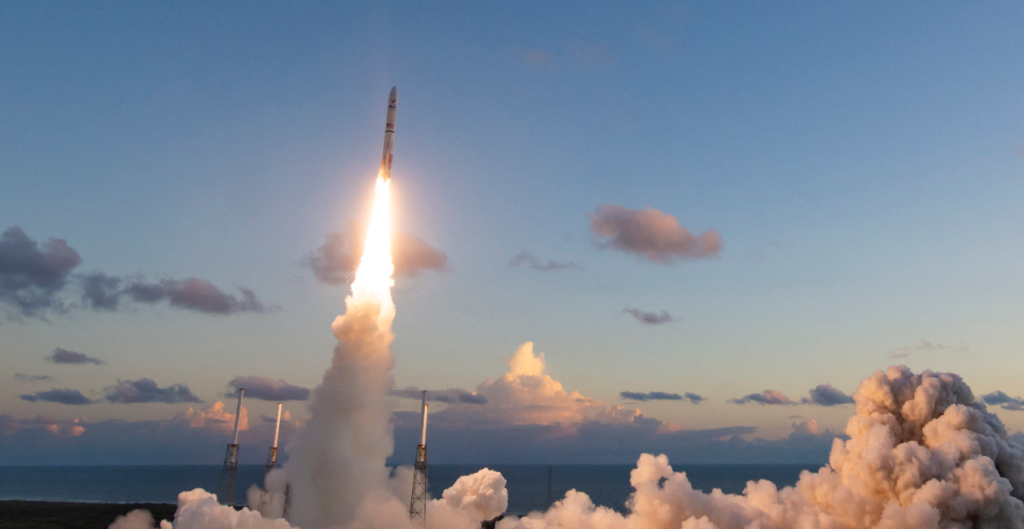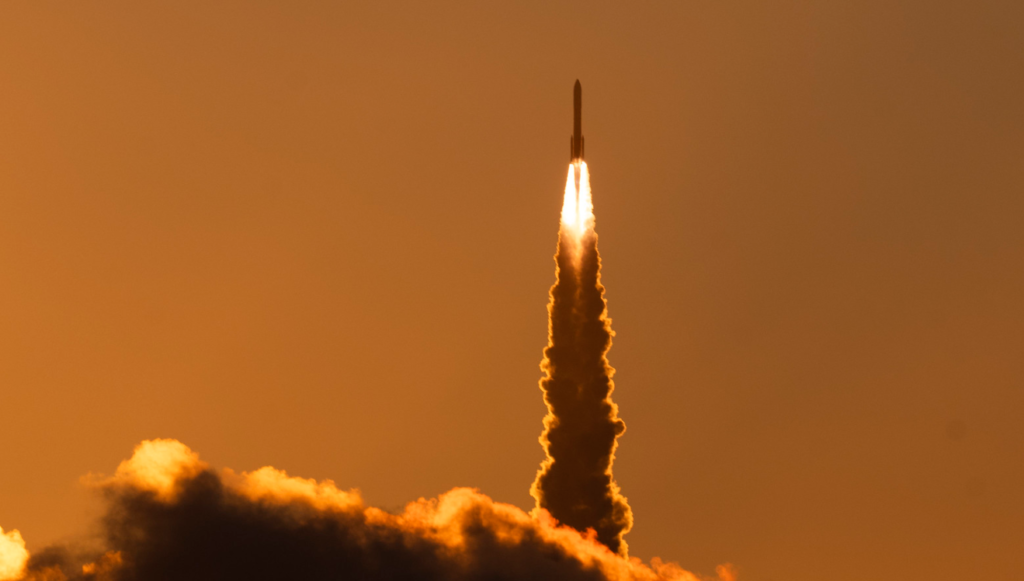Yesterday morning on the second-ever Vulcan launch the vehicle experienced an anomaly early in the flight with one of the Solid Rocket Booster nozzles being violently ejected. This resulted in reduced thrust along with an asymmetric thrust plume ultimately requiring a longer burn in order to compensate.
Despite this, the FAA released a statement confirming that they will not be requiring an investigation at this time. Some argue this comes in stark contrast to the treatment SpaceX has received regarding recent groundings and delays.
No Investigation Necessary

Despite the anomaly, Vulcan still managed to successfully reach orbit, and ULA CEO Tory Bruno even provided a chart of the insertion bullseye. While important, the fact of the matter is one of the two SRBs which provide almost a majority of the rocket’s thrust had its nozzle ejected changing the thrust profile and risking the mission outcome.
Soon after it was reported that the FAA issued an initial statement quoted saying, “The FAA assessed the operation and determined no investigation is warranted at this time.”
Hours later in another statement this time to NSF, they said, “The FAA is aware of the anomaly that occurred during the United Launch Alliance (ULA) Vulcan Centaur 2 mission that launched from Cape Canaveral Sapce Force Station in Florida on Oct. 4, 2024. This involved one of the solid rocket boosters. No public injuries or public property damage have been reported. The FAA is assessing the operation and will issue an updated statement if the agency determines an investigation is warranted.”
In response to this initial statement, Elon Musk responded to a tweet highlighting the decision with two question marks. This likely has to do with some of the investigations and groundings the FAA has begun on various SpaceX operations. For example, there was the recent grounding of the Falcon 9 after an upper-stage anomaly.
In this case, the second stage was successfully disposed of in the ocean however its burn was off-nominal and it landed outside the targeted zone. In a statement from SpaceX, they said. After today’s successful launch of Crew-9, Falcon 9’s second stage was disposed in the ocean as planned, but experienced an off-nominal deorbit burn. As a result, the second stage safely landed in the ocean, but outside of the targeted area. We will resume launching after we better understand root cause” they said.
Not long after the FAA issued a statement that said, “The FAA is aware an anomaly occurred during the SpaceX NASA Crew-9 mission that launched from Cape Canaveral Space Force Station in Florida on September 28. The incident involved the Falcon 9 second-stage landing outside of the designated hazard area. No public injuries or public property damage have been reported. The FAA is requiring an investigation” the statement said.
Recently the FAA has been in the spotlight as SpaceX works toward Starship flight 5 among other milestones. Last month SpaceX released an update highlighting that Flight 5 would not be able to launch any earlier than late November due to the FAA, despite readiness.
Specifically in that statement, the company said, “We recently received a launch license date estimate of late November from the FAA, the government agency responsible for licensing Starship flight tests. This is a more than two-month delay to the previously communicated date of mid-September. This delay was not based on a new safety concern, but instead driven by superfluous environmental analysis. The four open environmental issues are illustrative of the difficulties launch companies face in the current regulatory environment for launch and reentry licensing” they said.
While some thought that this might be changed to support a faster schedule, that doesn’t seem to be the case. A few days ago the FAA released a statement confirming that the next Starship flight is not expected to happen before late November. They specifically said, “SpaceX’s current license authorizing the Starship Flight 4 launch also allows for multiple flights of the same vehicle configuration and mission profile. SpaceX chose to modify both for its proposed Starship Flight 5 launch which triggered a more in-depth review. In addition, SpaceX submitted new information in mid-August detailing how the environmental impact of Flight 5 will cover a larger area than previously reviewed. This requires the FAA to consult with other agencies.”
“SpaceX must meet all safety, environmental, and other licensing requirements prior to FAA launch authorization. A final license determination for Starship Flight 5 is not expected before late November 2024” they said.
With this in mind, it seems that it could be at least a few months before a possible Starship launch approval and Flight 5. This combined with the Falcon 9 grounding has many wondering what makes some of these instances different from the Vulcan anomaly.
Beyond that, recently, we’ve seen a few anomalies occur related to the Falcon 9 as partially mentioned prior. In these cases, it’s normal to see the FAA require an investigation and at the same time acknowledge that there was no impact to public safety or property. With that in mind, they usually allow SpaceX to continue launching either right away or not long after. In other words, usually, if there is an anomaly with the launch, the FAA wants to know more.
The fact that the FAA has not officially begun an investigation into Vulcan’s anomaly despite the obvious concerns related to the booster is interesting. After the launch, Tory Bruno said, “All missions have propellant reserves. We add to that additional propellant margins based on the mass & the configuration of the rocket. Because this was compensated for within reserves, this anomaly was “invisible” to the rocket” he said. Even though Vulcan compensated well for the anomaly, it’s still a sizeable issue that they will need to address.
It’s also worth noting that the SRBs are lost in the ocean after each launch. This means ULA and Northrop will need to use photos and data collected during the launch to determine the issue and fix rather than having access to the hardware itself.
Vulcan’s SRB Anomaly

After the launch, ULA released an official statement about the launch and what to expect. They first were quoted saying, “United Launch Alliance (ULA) ushers in a new era of space capabilities with the successful launch of its second certification flight (Cert-2) of the next generation Vulcan rocket on Oct. 4 at 7:25 a.m. EDT from Space Launch Complex-41 at Cape Canaveral Space Force Station.”
CEO Tory Bruno said, “The success of Vulcan’s second certification flight heralds a new age of forward-looking technology committed to meeting the ever-growing requirements of space launch and supporting our nation’s assured access to space. We had an observation on one of our solid rocket boosters (SRB) that we are reviewing but we are overall pleased with the rocket’s performance and had a bullseye insertion. Vulcan provides high performance and greater affordability while continuing to deliver our unmatched reliability and orbital precision for all our customers across the national security, civil and commercial markets” he said.
They go on to say, “The Cert-2 mission served as the second of two certification flights required for the U.S. Space Force’s certification process and ULA has now completed all requirements for certification. ULA continues to work closely with the U.S. Space Force as they take the next few weeks to review the data and compare it to ULA’s first certification mission to ensure that the vehicle performed as expected and there are no additional items that need review. Once the evaluation is complete to the Space Force’s standards, the Vulcan rocket will be certified to launch national security missions” they said.
This statement suggests that despite the anomaly, they are on track to get certified in a timely manner and begin launching government missions quite frequently. Bruno then said, “The team will continue to modify our infrastructure as we work towards an accelerated launch cadence to meet our customers’ manifest requirements while building off today’s successful launch and developing future Vulcan upgrades, including SMART reuse plans for downrange, non-propulsive recovery of Vulcan engines.
In a final statement, the company said, “All rockets are not created equal. ULA is the nation’s most experienced, reliable and accurate launch service provider delivering unmatched value, a tireless drive to improve, and commitment to the extraordinary. Vulcan’s inaugural launch marked the beginning of a new era of space capabilities and provides higher performance and greater affordability while offering the world’s only high energy architecture rocket to deliver any payload, at any time, directly to any orbit” they said.
By now, ULA has sold more than 70 Vulcan launches to date, including 38 missions for Amazon’s Project Kuiper and multiple national security space launch missions as the part of the country’s Phase 2 launch procurement. Not long from now in the future, we can expect the launches to start ramping up.
Mark Peller, the vice president of Vulcan Development said, “Vulcan is built with the strength of a national workforce whose unmatched dedication and innovation has modernized the very best of our industry-leading heritage. The foundation of Vulcan’s purpose-built design rests on the best of what we’ve learned from more than 130 combined years of launch experience with Atlas and Delta.”
Conclusion
As of right now, the FAA is not requiring an investigation into the SRB anomaly on Vulcan’s second launch. At the same time SpaceX is trying to get approved for a 5th Starship flight and get the Falcon 9 launching consistently again.
